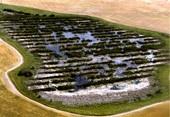 Treated wetlands
Treated wetlands
Repellents
There are a number of bird repellants on the market. Caged efficacy trials conducted by USDA shows limited repellency.
Research
DRC 1339 is an avicide that is registered but can only be applied by USDA APHIS Wildlife Serivices personnel for use to eliminate blackbirds 'doing or about to do damage'. The challenge has been to get the blackbirds into a feeding site when there are large fields of sunflower or corn nearby. This product is used widely in other areas of the country when the birds have few feeding options. Work will continue in the sunflower region. There is a lot of interest in additional repellants. New products are being tested in caged trials and in field trials. Products with good efficacy will be brought to market as soon as possible.
National Scope
Blackbirds are the single largest bird population in North America. A cautious damage estimate of $200 million dollars annually is done to a multitude of crops and livestock. There are serious concerns about human and animal health in areas where large flocks overwinter, especially in urban areas. There are major concerns about aircraft/airport safety. Efforts are in place to create a national plan to deal with this pest.
NSA Funded Research
There are a number of research papers available for review on the NSA web site that describes studies conducted on bird predation. Go to the searchable Research Forum page and select the "Bird Predation" category for more information.